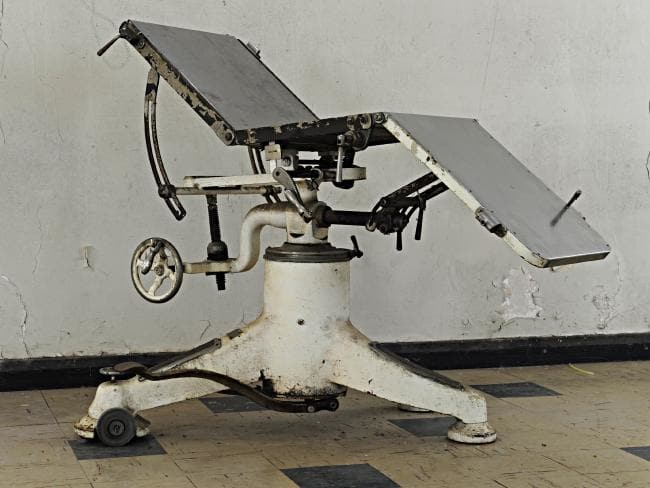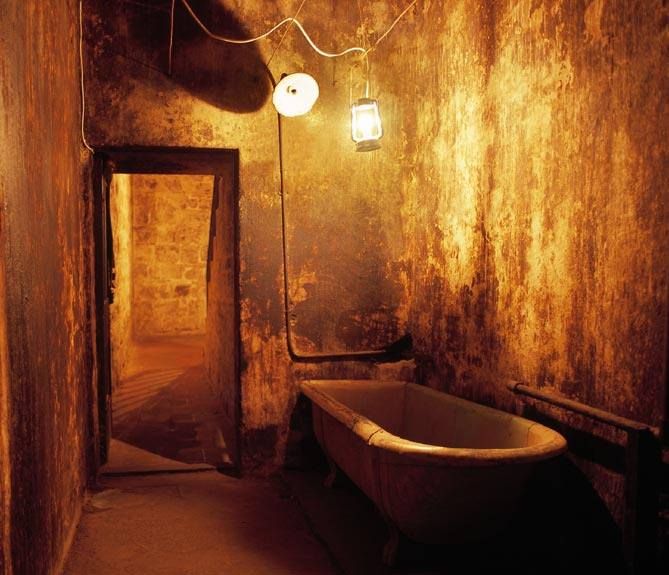1863. The infamous year when ground broke for a new institution. A hospital that, for the people of Ararat, Australia, would loom over their small, rural community in a most unsettling way… an ominous structure built to house those deemed insane by the state. The people, mostly farmers and small town folk, lived in its shadow for 130 long years, knowing all the while that almost anyone could end up there. Many lived in fear of one day being locked up with no end in sight to their misery…
The Aradale Lunatic Asylum has a haunted past that marks its continued presence in the hills, and stories abound about the strange happenings that still take place behind its stonewalls. Part of three planned structures, the Aradale asylum was one of the largest institutions in all of Australia for the mentally insane. It boasted its own orchards and fields for growing, as well as a piggery to top it off. An enclosed compound comprised of approximately 63 buildings, Aradale employed up to 500 employees during the height of its grandeur. The style of the buildings resembles rolling, lavish Havana architecture (to my non-expert eye) which was inspired by one of the most successful institutions in all of Britain, the Colney Hatch Mental Hospital in Friern Barnet, London.
The look on the exterior was clean, bright, and wholesome looking to the untrained eye. The walls surrounding the institution appear less daunting than the nearby prisons, which tower high with barbed wire draped across like shimmering Christmas garland. What outsiders did ‘t know is that these exterior walls were nicknamed Ha-Ha walls. Actually termed ‘ditch-walls’, they were designed to appear topical from the outside, but in reality deep ditches were dug on the inside, greatly increasing the height of the barrier to the prisoners inside.
The purpose of such institutions was to create a separation between criminals and those considered to be ‘lunatics’, ‘insane’ or ‘retarded’. During the 1860’s Australia was thought of as the backwater of the British Commonwealth - a place where criminals, misfits and the insufferable alike found themselves in the wake of a booming gold rush. It was a brutal time when those who were ill, depressed or made mistakes could be locked away for their entire lives, subject to types of suffering reserved only for our nightmares.
Like most institutions of its era, Aradale was shrouded in fear and mystery for the folks on the outside. Asylums in Australia had some of the worst reputations for brutality and neglect, and Aradale was no exception. Up until the 1970’s a person could be thrown into Aradale for simply being a homosexual, an alcoholic, or have a mental illness such as post-partum depression. Many women who entered Aradale over a diagnosis of melancholia never left...
Entry into the asylum required the signatures of TWO doctors. To get out? You needed 8 different signatures! In many documented cases, men who grew tired of their wives for whatever reason would pull favours amongst friends and have their wife locked up for no good reason - only to replace her soon after with another young lassie! In many cases it was safe to say that imprisonment behind the walls of Aradale was more of a death sentence than a treatment plan. It is said that roughly ⅓ of patients entering the Asylum would never see freedom again. Women were admitted at the minimum age of 14, while for men it was 17 years of age.
Many chose their escape on The Bridge, more commonly known as the suicide walk, which is the upper storey walkway that separates the men’s ward from the women’s. To this day, those that pass over the walk claim to feel their arms and legs being pulled back, or pulled toward the edge of the walk. Are these restless spirits reaching out in regret of their final act, or are they trying to pull still others along with them into death?
There were also those who considered Aradale their home, individuals who were thoroughly institutionalized and dependent on the state for a roof over their head and food on their plate, no matter how terrible it was. One such patient, known as Old Margaret, was a nearly life-long resident of the asylum until its closure in the 1990’s when she was forced to move during her last years. Her ghost is said to haunt the halls of the asylum, as it is the only home she ever knew.
Bill Wallace was another notorious inmate of Aradale, and resided in J-Ward, the block reserved for the criminally insane, for 64 years of his life. Mr. Wallace came to Aradale as a patient at the age of 41, after he was suspected of shooting a man over a cigarette in a Melbourne cafe in 1926. Wallace was arrested at the scene of the crime but refused to confess or talk to police nor the psychiatric doctors, two of which declared the man insane. This designation landed Wallace at Aradale as a ward of the Governor at the Governor’s Pleasure - meaning no minimum or maximum sentence was ever placed on Wallace. As a patient, Mr. Wallace was institutionalized indefinitely and theoretically would be released if the governor was convinced he was ‘cured’.
Mr. Wallace never communicated with his doctors, which lead to a lifetime of institutionalization. Wallace was incarcerated until his death in 1989 at the age of 107, making him the oldest patient/prisoner of the facility. Ironically, perhaps, he was one of the heaviest smokers Aradale ever saw… preferring 50 pound blocks of government issue Tobacco. Wallace always wore suits, and had an annual fitting at Aradale’s own suit shop called “Fosters”, and preferred to be called Mr. Wallace, and acted as any proper gentlemen would, unless provoked into violence. Wallace’s character could be likened to that of Hannibal Lecter… who preferred to kill the rude, those who offended his tastes and good manner.
“if provoked, Mr Wallace was said to be ‘fully capable of kicking one’s head off’. Even at the age of 100 he was capable of becoming violent. One night in the dining hall the inmate were eating dinner. One inmate asked Mr Wallace if he wanted to eat the last slice of bread on his plate while reaching across the table. In response he picked up a fork and stabbed it into the hand of the inmate.” (Chumacero 2018)
Mr. Wallace could be characterized as a through-and-through insitiutionalized person… akin to that of Shawshank Redemption’s character Brooks, who killed himself as an elderly man after being released into the general public after decades of living behind bars. The staff had taken to Wallace, even gifting him a beautiful chess set for his 100th birthday. Soon after Wallace’s momentous birthday, public caught wind that there was a centennial living behind the walls of Aradale. Three years of petitioning eventually convinced the Governor to release Mr. Wallace. But there was one problem: Wallace didn’t want to leave! His famous words were: “Don’t be f***ing silly, I live here.”
Wallace would live out the remainder of his life in the Geriatric ward of Aradale, he died one month shy of turning 108 years old.
THE HAUNTINGS OF ARADALE ASYLUM
According to a Ghost Cases Australia YouTube documentary, there were only three official executions carried out at J-Ward. The bodies were buried unnaturally, standing upright in shallow unmarked graves, their spirits forever left to wander the grounds of the institution. In all cases the offence committed was murder, although not all murderers (convicted or not) were treated to capital punishment for their offences, and the executions were halted by the beginning of the 20th century. Since the institution has re-opened for tours, the Friends of J-Ward Society have hung plaques in remembrance of the those three executed prisoners.
Despite the low number of officially sanctioned deaths at Aradale Lunatic Asylum, roughly 13,000 people died in total during the 130 years the institution was open for. What this means that all those others of the Asylum died in unofficial, unordered and often murderous circumstances…
“Reports of hauntings talk about nurses in white uniforms, crying, moaning and footsteps.”
The infamous Nurse Kerry haunts the women’s ward, and has been seen watching tour groups from a distance. Many who encounter Kerry describe the ghostly nurse as sporting an icy mean stare, so cold it practically compels people to leave her ward, the implication of her gaze surely that she does not want to you to see what goes on in behind closed curtains. Interestingly, in life Kerry was predominately described as a sweet nurse with a soft soothing voice capable of calming any patient down. One visitor who dared tour the asylum related a story of Nurse Kerry who, among a few other nurses, had attempted to get patient to eat. After refusing repeatedly the nurses restrained the uncooperative patient and used a long metal spoon to physically shove her meal down her throat; when the spoon was removed the patient began choking up copious amounts of blood and died right there in front of everyone.
While visiting the Men’s Surgery Ward, many visitors report feelings of being touched or pressed on, as if spectral forces are trying to push them away from danger. No doubt many a questionable procedure was performed in those haunted hospital halls, everything from experimental electric shock therapy to lobotomies were undertaken on patients during a time when psychiatric theories and treatments were poorly understood and administered cruelly with terrible results. One of the most common treatments, however, was restraint and isolation.
Violence is not an uncommon report as well amongst visitors of Aradale. Sightings have occurred in the presence of caretakers and tour guides, such as the ghostly figure of a woman being beaten over the head in the kitchen. One paranormal investigator was attacked by an invisible force while conducting experiments in the gaol, while in another case a touring visitor in the area of J-Ward was violently bitten on the neck while examining the strait jackets, however, when he went to examine the wound in the light of day it had vanished...
Perhaps one of the scariest accounts of spectral phenomena to occur in J-Ward was the possession of a ghost hunter while she was in a particularly dreaded area of the institution. Many before her had claimed to have been literally pushed out be an unknown compelling force as if the air itself was too oppressive to wade through. It was here that an unnamed woman one woman became unresponsive to all around her. As her friends attempted to communicate to her, the woman’s neck stretched back unnaturally, while her eyes rolled into the back of her head. She exhibited a zombie like trance until she exited the building, where upon she regained her senses.
Allegedly, one of the early superintendents of Aradale, for whatever reason, killed himself by ingesting Prussic Acid. Many visitors who stand on the spot in his office where the man died have a strange, unpleasant taste form in their mouths, as if remnants or echoes of a traumatic past are present in the space.
It seems that the site of Aradale Asylum is rampant with activity still, only this time that of the paranormal variety. Many speculate that the trauma of the patients who called Aradale home, some for small amounts of time, while for the majority freedom was never an option once entering the iron gate to the sprawling grounds of the asylum. The terrible historical reality of past psychiatric institutions has given Aradale it’s glowing reputation as Australia’s most haunted, but do the stories speak of a reality, or are they simply tall tales stirred up from the necessary secrecy of a walled hospital set into the pastoral countryside.
What’s your take on ghosts, and places that are said to be haunted? Reach out at Intotheportalmailbox@gmail.com or comment below!
________________
Written by Amber Rae Bouchard










